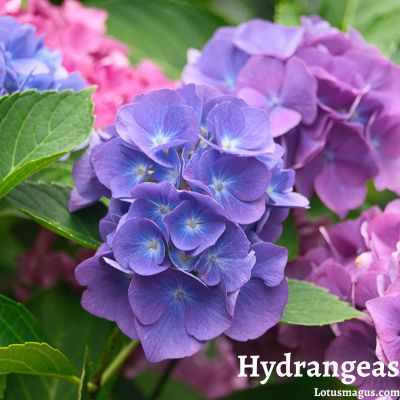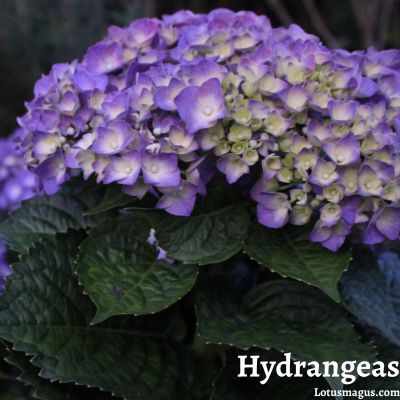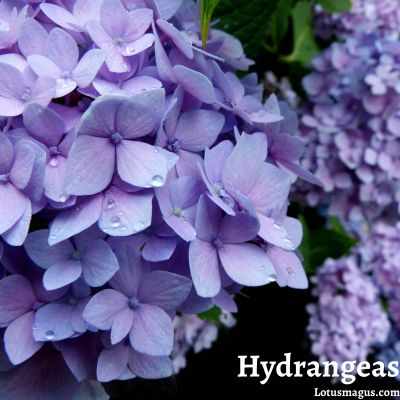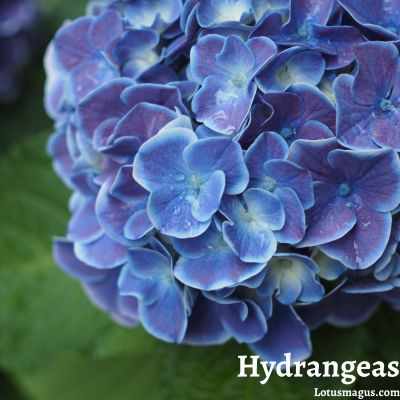Beautiful plants like hydrangeas provide color and liveliness to any garden. Knowing when and how to prune them, nevertheless, is crucial to ensuring their well-being and healthy development. The appropriate timing to prune hydrangeas may promote more flowers, stronger stems, and healthier foliage. In this article, we’ll discuss the best time to cut back hydrangeas for winter and provide you with practical tips on how to do it.
Why Cut Back Hydrangeas?
Let’s briefly go over why you should prune your hydrangeas in the first place before we get into the “when” and “how.” Doing hydrangea pruning can:
- Promote new growth: Pruning your plant on a regular basis will encourage it to develop new branches and more flowers, which will make your shrub fuller and healthier.
- Eliminate dead or diseased stems to stop the spread of noxious pathogens and pests that might harm your plant.
- Keep the intended form and size of the plant: Pruning keeps your hydrangea shrub from overgrowing or becoming too lanky and helps it maintain the correct shape and size.
When to Cut Back Hydrangeas for Winter
In general, late winter, just before new growth starts, is the optimum time to cut back hydrangeas. And this helps your hydrangeas to grow and develop properly. Identification of your hydrangea type is crucial before cuttings since various hydrangea species call for different pruning methods and schedules.

Hydrangeas that Bloom on Old Wood
Old-growth bloomers, or hydrangeas that bloom on old wood, form their buds in the preceding growing season. This species should be trimmed as soon as possible after flowering, in late summer or early autumn, to give new buds ample time to grow for the next season. Old-growth bloomers include, for example:
Table of Contents
- Large-leafed hydrangeas (Hydrangea macrophylla)
- Oak-leaf hydrangeas (Hydrangea quercifolia)
- ascent of hydrangeas (Hydrangea anomala petiolaris)
Hydrangeas that Bloom on New Wood
The buds of hydrangeas that bloom on new wood, sometimes referred to as new-growth bloomers, form on the growth of the current season. Before new growth starts, these plants should be trimmed in late winter or early spring. New-growth bloomers include, for instance:
- Hydrangeas that are not thorny (Hydrangea arborescens)
- Hydrangeas peegee (Hydrangea paniculata)
- Hydrangeas of Endless Summer (Hydrangea macrophylla Endless Summer series)
How to Cut Back Hydrangeas for Winter

Now that you know when to cut back your hydrangeas let’s discuss how to do it properly.
Step 1: Prepare the tools
Gathering the required equipment, such as razor-sharp pruning shears or loppers, gloves, and safety goggles, is the first step. To stop the transmission of infections, make sure the equipment is clean and sanitized.
Step 2: Identify the dead or diseased stems
Examine the plant carefully and note any dead or unhealthy stems before trimming. Although infected stems may have black or brown patches, cankers, or mildew, dead stems are dry, brittle, and readily break. Sharp pruning shears should be used to cut these stems all the way to the plant’s base.
Step 3: Prune the overgrown stems
After that, trim the excess stems to keep the plant’s ideal size and form. At the place where a leaf or bud first appears from the stem, trim the stems immediately above the leaf node. Cut away from the node as much as possible to avoid harm to the plant and future development. To aid in healing and avoid water buildup on the cut area, make the incision at a 45 degree angle.
Step 4: Remove the weak or crossing stems
To improve airflow and keep the branches from rubbing against one another, cut away any weak or crossed stems. To promote new development, cut the stems slightly above a robust bud or branch.
Step 5: Clean up the plant debris
After pruning, remove any plant waste from the ground and properly dispose of it. This will maintain your landscape neat and stop the spread of illnesses and pests.
Tips for Cutting Back Hydrangeas
- To avoid the plant from being harmed, always use sharp pruning shears.
- Pruning hydrangeas in the sweltering summer may stress the plant and prevent it from putting out new growth.
- Pruning more than one-third of the plant’s overall growth in one season might weaken the plant and impair its capacity to bloom.
- After trimming, don’t forget to fertilize your hydrangeas to encourage strong growth and flowering.
How far do you cut back hydrangeas in the winter?
The kind of hydrangea and the time of year it blooms determine how much trimming need be done in the winter. It should be clipped in late winter or early spring if the hydrangea is a new wood blooming. But, when the blooms have gone, old wood bloomers need to be pruned.
In late winter, just before new growth starts, flowering new wood hydrangeas should be pruned down to a height of approximately two feet. This will encourage strong, fresh growth, which will produce the flowers the following season. Old wood flowering hydrangeas, on the other hand, need to be clipped just after the flowers have gone. This is because old wood bloomers, which set their buds in the previous season, might have their blooming diminished or completely eliminated by winter pruning.
It’s crucial to remember that a bigleaf hydrangea is best pruned just after it has finished flowering. The shrub will have plenty of time before winter to establish new growth and harden off. Similarily, wait until spring or summer after the plants have bloomed to do hydrangea trimming tasks. Any dead stems or blossoms will quickly be covered by new growth, giving you a clear picture of which branches need to be pruned.
To prevent harming the plant, it’s essential to prune hydrangeas with the proper equipment. Use loppers for heavier branches and pruning shears for thinner ones. Clean cuttings are also necessary to lower the danger of illness and encourage robust growth.
Also Read : Pruning Hydrangeas in Spring : Should I? Tips and Techniques
Can you cut hydrangeas down to the ground in winter?
In late winter or early spring, smooth hydrangeas that bloom on new wood may be completely pruned down to the ground. The aggressive trimming will encourage more robust development and greater flowers. Other gardeners, on the other hand, prefer smaller blossoms on stronger stems and choose less drastic trimming.
In contrast, bigleaf and oakleaf hydrangeas, which bloom on ancient wood, shouldn’t be clipped in the winter. These hydrangeas form their buds in the season before, and winter trimming might lessen or even stop blossoming. Just after they have finished flowering in the summer is the ideal time to prune old wood bloomers.
It’s vital to remember that using the proper pruning tools is essential to prevent plant damage while trimming hydrangeas. Use loppers for heavier branches and pruning shears for thinner ones. To lower the danger of sickness and encourage healthy development, clean cuts are also crucial.
Should I cut off brown hydrangea blooms in winter?
The optimum time to cease deadheading hydrangea bushes is in the middle to late October, leaving any fallen flowers in situ, according to gardening experts. This is so that the plant will be somewhat protected from the severe winter cold over the winter by the dried blossoms. Also, the brown blossoms give the landscape a rustic and natural appearance, which makes them ideal for winter gardening.
Although deadheading in the winter is not required, you may remove the brown blossoms if you don’t like the way they look. Even so, some individuals decide to cut the blossoms while they’re still vibrant and use them for bouquets or home accents.
It’s crucial to remember that trimming hydrangeas in the winter requires extreme prudence. Old-wood blooming hydrangeas need to be pruned shortly after summer flowering, whereas new-wood blooming hydrangeas should be pruned in late January before new growth starts. It’s recommended to get advice from a local gardening professional or follow the particular pruning instructions for your area if you’re unclear about your hydrangea type or when to trim.
How do I prepare my hydrangeas for winter?

Two fundamental actions you can do to get hydrangeas ready for winter are to thoroughly water them and cover them with mulch.
To keep the plants hydrated and healthy for the next winter, water hydrangeas thoroughly twice or three times in late October. This is particularly important for hydrangeas grown in pots since they tend to dry up more quickly than those grown in the ground. Be careful to water around the plant’s base rather than directly on the leaves when watering hydrangeas.
Applying mulch is the next stage in getting hydrangeas ready for the winter. Apply a 6 to 8 inch layer of mulch around the base of the plant when the earth freezes, which often happens in late October in the North. Mulch aids in the plant’s insulation and defense against the heave-ho of spring freeze/thaw cycles. This may force the plant out of the ground, exposing the roots, which might be highly harmful.
You have a few options for mulch, including straw, bark mulch, and chopped up leaves. Apply the mulch around the plant’s base in a circle, keeping space between it and the stems to avoid moisture accumulation and subsequent rot.
Moreover, you may trim away any weak or dead branches by chopping them off at the plant’s root. Hydrangeas may grow back larger and stronger the following spring by being pruned in the late autumn or early winter.
Do I need to cover my hydrangeas for winter?
In general, it’s a good idea to give cover for additional protection for your hydrangeas if you reside in a cold environment where temperatures often go below freezing. Applying mulch around the plant’s base is one of the easiest techniques. This will prevent the soil from freezing and aid with soil insulation. Apply the mulch in the North when the ground freezes in the late autumn. A coating of 2 to 3 inches is ideal.
You may cover your hydrangeas with burlap or other insulating materials in addition to mulch. This is crucial for hydrangeas, particularly mophead/bigleaf varieties that bloom on old wood and are only moderately resilient. The plants may be shielded from freezing temperatures and frost damage by being wrapped or covered. The majority of insulating materials, however, tend to pack down with time, so it’s crucial to make sure the material is firmly attached to the surface.
Before to the first frost, it is recommended to bring inside any potted hydrangeas you may have. This will provide the greatest defense against the cold.
Remember that not all hydrangeas need to be protected from the winter elements. You may not need to cover your hydrangeas at all if you live somewhere with a warmer temperature or if you have a hardier type. A hydrangea should typically be able to withstand most winter conditions without further protection if it is hardy to at least zone 5.
It’s crucial to water your hydrangeas deeply twice or three times in late October to ensure that they remain hydrated throughout the winter in addition to protecting them from the cold. Moreover, remember to deadhead your hydrangeas regularly during the growing season to maintain their finest appearance and promote new growth.
Hydrangeas winter care and maintenance

Here are some recommendations for winter maintenance and care of hydrangeas based on data from many trustworthy sources.
Hydrangeas must be kept hydrated above anything else throughout the autumn season. Water hydrangeas thoroughly a few times to make sure they are well hydrated before winter arrives. This will enable them to resist the icy airbursts that accompany winter. According to Better Homes and Gardens, hydrangea stems will be better able to retain moisture in the autumn and prevent drying out, which might be disastrous throughout the winter.
Protecting the plant from the winter winds is a crucial part of hydrangea winter maintenance. According to HGTV, a layer of mulch placed around the base of the plant may serve as insulation, insulating the roots from the cold and keeping them warm. Mulch can also aid in keeping the soil moist, which is necessary for the growth and health of hydrangeas.
Whether hydrangeas require winter pruning is one frequent query. According to Gardening Know How, it’s advisable to remove any dead or weak branches by cutting them to the ground and to remove any old wood at the plant’s base. By doing this, you may assure that the plant develops quickly in the spring.
It’s crucial to monitor the weather as winter wears on and provide the hydrangeas extra protection as necessary. To offer more nutrients and insulation, All About Gardening advises spreading a layer of compost around the base of the plant.
Conclusion
The appropriate timing to prune your hydrangeas may encourage strong growth, more flowers, and stronger stems. Late summer or early autumn is the ideal time to trim hydrangeas that bloom on old wood, while late winter or early spring is the ideal time to prune those that bloom on new wood. You may have a beautiful and healthy hydrangea bush in your yard by using the right pruning methods and advice.
FAQs
- Can you cut back hydrangeas in the summer?
Cutting down hydrangeas in the summer might stress the plant and prevent it from sprouting new growth, thus it is not advised. Instead, cut your hydrangeas early in the spring or late in the winter before new growth appears.
- How much should you prune hydrangeas?
A plant may become weak and lose its capacity to bloom if more than one-third of its total growth is pruned in a single season.
- What is the best time to prune Peegee hydrangeas?
Before new growth starts, Peegee hydrangeas should be clipped in late winter or early spring.
- How can I tell if my hydrangea blooms on old or new wood?
The buds on hydrangeas that bloom on old wood form during the previous growing season, whereas the buds on hydrangeas that bloom on new wood form during the present growing season. To identify your hydrangea kind, look at the plant’s label or speak with a gardening professional.
- Can you prune hydrangeas in the fall?
Hydrangeas that bloom on old wood should be clipped as soon as they finish flowering, in late summer or early autumn. If hydrangeas bloom on fresh wood, pruning them in the autumn is not advised since it may reduce their capacity to bloom the next season.
- How do I prevent diseases when pruning my hydrangeas?
Identify and remove any dead or diseased stems, as well as clear up the plant waste from the ground after trimming, in order to stop the spread of illnesses.
- Can I cut back hydrangeas in the spring?
In order to avoid removing the flower buds and preventing blossoming, it is not advised to prune hydrangeas in the spring. Instead, cut your hydrangeas early in the spring or late in the winter before new growth appears.
- How do I prune climbing hydrangeas?
After flowering in the late summer or early autumn, climbing hydrangeas should be clipped right away to give new buds time to form for the next season. To keep the plant in the proper form and size, remove any dead or diseased branches and clip any overgrown or crossing stems.
- What should I do if I prune my hydrangeas too much?
Do not panic if you mistakenly pruned your hydrangeas too severely. The plant will bounce back, but it can take a season or two for it to start blooming once again. To encourage healthy development in the meantime, be sure to fertilize and water the plant often.
- Can I prune hydrangeas in the rain?
Hydrangeas should not be pruned in the rain since this increases the danger of pests and disease. When trimming your hydrangeas, wait for a dry day and make sure to clean your equipment both before and after each usage.
- Can I shape my hydrangeas into a specific form?
Sure, by giving them the proper amount of trimming, you may give your hydrangeas a certain shape. However it’s crucial to remember that hydrangeas have a natural shape, and pruning them too much or into an unusual shape might have an impact on their development and flowering.
- What should I do if my hydrangeas are not blooming?
Inadequate pruning or other conditions, such as a lack of sunshine, water, or nutrients, may be to blame for your hydrangeas’ failure to blossom. Determine what kind of hydrangea you have, and be sure you prune it properly and at the appropriate time. To encourage flowering, check the plant’s needs for water and sunshine and feed with a balanced fertilizer.
- Can I prune my hydrangeas to control their size?
Yes, you may trim your hydrangeas to keep them from overgrowing and to keep their size under control. But, be cautious while trimming them and avoid doing too much in one season as this might reduce their ability to bloom.
- How can I promote thicker stems in my hydrangeas?
Regularly trim your hydrangeas to eliminate any weak or crossing stems, and treat them with a balanced fertilizer to encourage stronger stems. To keep moisture in and encourage healthy development, you may also sprinkle a layer of organic mulch around the base of the plant.
- Can I prune my hydrangeas after they bloom?
Your hydrangea’s kind will determine what happens. Hydrangeas that bloom in the late summer or early autumn on old wood should be clipped right away. Nevertheless, before new growth starts, late winter or early spring pruning is advised for hydrangeas that bloom on new wood.
Related Post:
